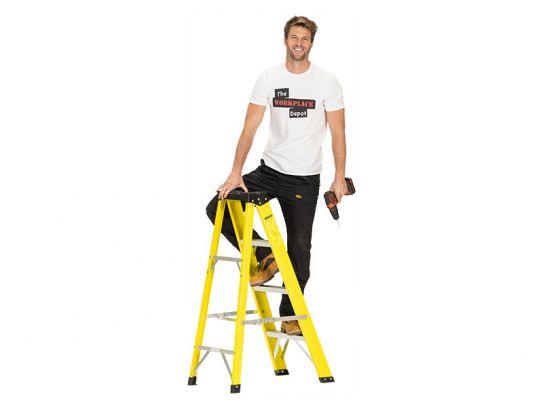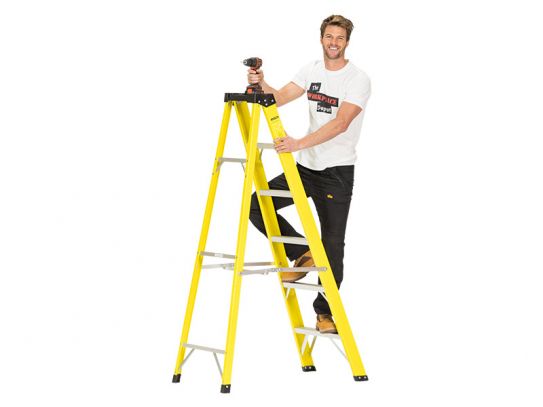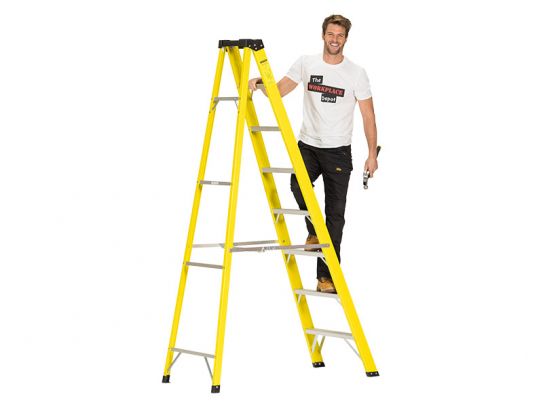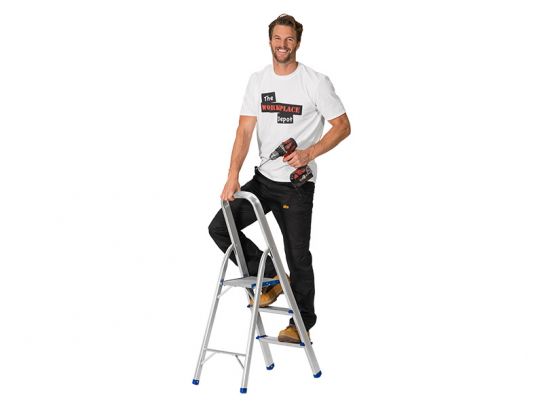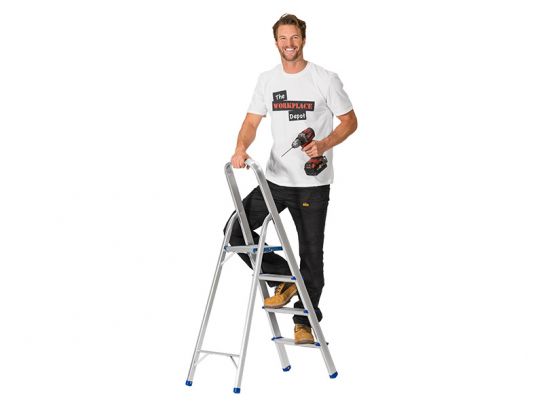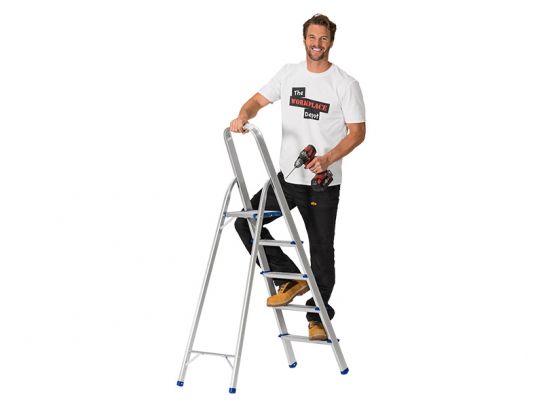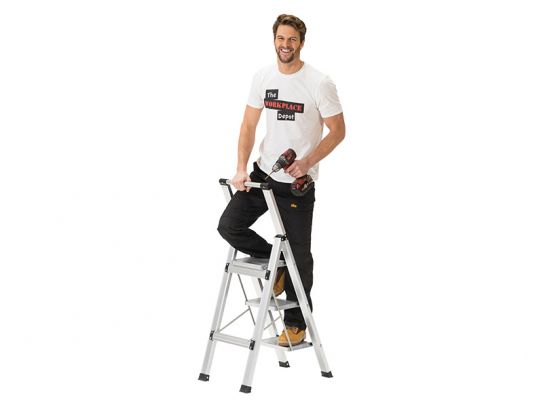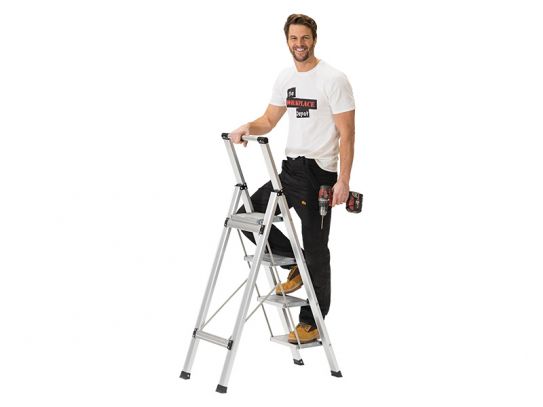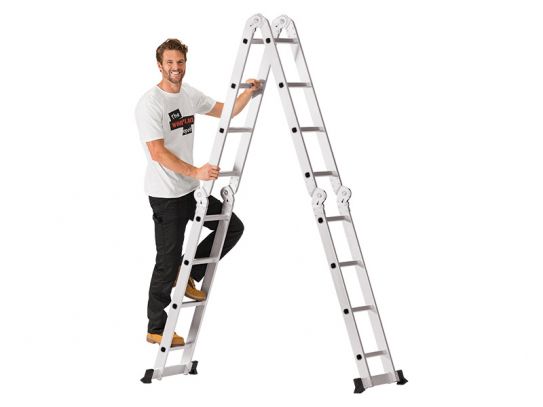Step Ladders
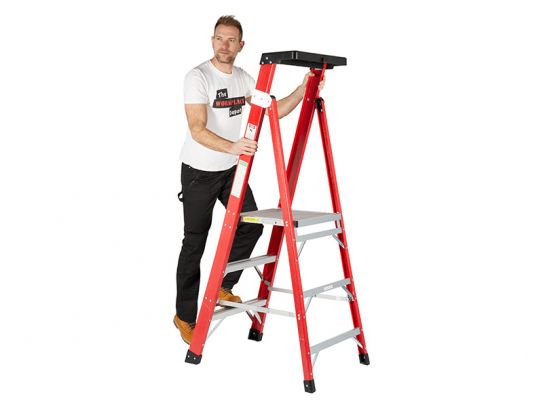
Stepping up to the Task, One Rung at a Time.
Are you tired of straining to reach high shelves or struggling to change a lightbulb? Do you want a safe and effective way to access overhead areas in your home or office? Look no further than our step ladders!
With a sturdy design and durable construction, our step ladders are built to last. They are available in a range of sizes and styles, so you can find the perfect ladder to suit your needs. Whether you're painting a ceiling, cleaning windows, or installing shelves, our step ladders are the perfect tool for the job.
But don't just take our word for it – try one of our step ladders for yourself and see the difference. With their non-slip steps and secure locking mechanisms, our ladders provide a safe and stable platform for all your height-related tasks. Plus, their compact size and lightweight design make them easy to store and transport, so you can take them with you wherever you go.
What Are Step Ladders?
A step ladder is a type of ladder that is designed to help a person reach a higher height. It typically has two sections, each of which has several steps that can be climbed to access the desired height. Step ladders are typically made of metal or fibreglass and are commonly used in homes, offices, and other settings where a person may need to reach a height that is out of their normal range. They are a safe and effective tool for accessing overhead areas and are a common sight in many households and workplaces.
What Are Some Common Uses for Step Ladders?
Step ladders are a versatile tool that can be used for a wide range of tasks. Some common uses for step ladders include:
- Painting walls and ceilings
- Changing light bulbs
- Cleaning windows
- Installing shelves and other storage solutions
- Reaching items stored in high spaces or on top shelves in warehouses
- Performing basic repairs around the home or office
- Pruning trees and shrubs
- Any other task that requires accessing a height that is out of reach from the ground.
What Are the Different Types of Step Ladders?
In general, step ladders are an essential tool for anyone who needs to safely access overhead areas. They are a convenient and effective way to reach heights that would otherwise be difficult or impossible to access.
There are several different types of step ladders that are available, and the best type for a given situation will depend on the specific needs of the user. Some common types of step ladders include:
- Single-sided step ladders: These ladders have steps on one side only, and they are designed to be leaned against a wall or other vertical surface for support.
- Double-sided step ladders: These ladders have steps on both sides and can be used in the middle of a room or other open space.
- Platform step ladders: These ladders have a large, flat platform at the top that provides a stable and secure standing surface. They are often used for tasks that require a person to stand in place for an extended period of time, such as painting or installing shelving.
- Folding step ladders: These ladders are designed to be easily folded up for storage when not in use. They are a convenient option for people who need a ladder but don't have a lot of storage space.
- Telescoping step ladders: These ladders have sections that can be extended or retracted to adjust the height of the ladder. They are a versatile option that can be used for a wide range of tasks.
In addition to these types, step ladders are also available in a range of sizes, with varying numbers of steps and heights. The right size and type of step ladder will depend on the specific needs of the user and the tasks that it will be used for.
What Are the Key Features to Consider When Choosing Step Ladders?
When choosing a step ladder, there are several key features to consider in order to ensure that the ladder is safe, durable, and suitable for the intended tasks. Some important factors to consider include:
- Size: The size of the step ladder is an important factor to consider, as it will determine the height that can be accessed and the overall stability of the ladder. It is important to choose a ladder that is tall enough to reach the desired height, but not so tall that it becomes unstable.
- Material: Step ladders are typically made of metal or fibreglass. Metal ladders are generally more durable and heavy-duty, but they can be heavy and difficult to move. Fibreglass ladders are lighter and easier to move, but they may not be as durable as metal ladders.
- Weight capacity: All step ladders have a maximum weight capacity, and it is important to choose a ladder that can safely support the weight of the user and any tools or materials that will be carried on the ladder.
- Number of steps: Step ladders are available with varying numbers of steps, and it is important to choose a ladder with enough steps to provide a safe and stable climbing surface.
- Type: As discussed above, there are several different types of step ladders available, and the right type will depend on the specific needs of the user and the tasks that the ladder will be used for.
- Safety features: Look for a step ladder that has safety features such as non-slip steps, locking mechanisms to prevent the ladder from collapsing, and other features that will help to ensure the safety of the user.
By considering these factors, you can choose a step ladder that is safe, durable, and suitable for your needs.
How Should I Maintain My Step Ladders?
Proper maintenance is important for keeping your step ladder in good working condition and ensuring that it is safe to use. Some simple steps that you can take to maintain your step ladder include:
- Store the ladder in a dry, well-ventilated area to prevent it from rusting or deteriorating.
- Clean the ladder regularly to remove dirt, grime, and other debris that can build up on the steps and other parts of the ladder.
- Inspect the ladder before each use to make sure that it is in good condition and free of any visible damage or defects.
- Tighten any loose bolts or other hardware to ensure that the ladder is secure and stable.
- Replace any worn or damaged parts, such as non-slip pads on the steps or locking mechanisms on the hinges.
- Follow the manufacturer's instructions for proper use and maintenance of the ladder.
By following these steps, you can help to ensure that your step ladder is safe and reliable for use. It is also a good idea to periodically check the ladder for signs of wear and tear, and to replace it if it becomes damaged or unsafe to use.
Are There Any Special Considerations When Choosing a Step Ladder for a Particular Environment?
When choosing a step ladder, it is important to consider the specific environment and application in which the ladder will be used. This will help to ensure that the ladder is suitable for the intended tasks and will provide the necessary stability and safety. Some factors to consider include:
- The height that needs to be reached: Choose a ladder that is tall enough to reach the desired height, but not so tall that it becomes unstable.
- The weight of the user and any materials that will be carried on the ladder: Choose a ladder with a high enough weight capacity to support the user and any tools or materials that will be carried on the ladder.
- The type of surface that the ladder will be used on: Choose a ladder with non-slip steps and feet to ensure that it stays securely in place on the ground.
- The type of tasks that the ladder will be used for: Choose a ladder with the right type and number of steps to provide a safe and stable climbing surface for the intended tasks.
- The conditions in which the ladder will be used: Consider factors such as weather, temperature, and other environmental conditions that may affect the performance of the ladder.
By taking these factors into account, you can choose a step ladder that is well-suited to the specific environment and application in which it will be used. This will help to ensure that the ladder is safe, stable, and effective for the intended tasks.
Are There Any EU or UK Standards That Affect Step Ladders?
In the UK and EU, step ladders are subject to a number of standards and regulations that are designed to ensure their safety and effectiveness. Some of the key standards that apply to step ladders include:
- BS EN 131: This is the main standard that applies to step ladders in the UK and EU. It specifies the minimum requirements for the design, construction, testing, and marking of step ladders. It covers factors such as strength, stability, durability, and safety features.
- BS EN 14183: This standard applies to mobile ladders, which include step ladders that can be moved from one location to another. It specifies the minimum requirements for the design, construction, testing, and marking of mobile ladders.
- The Workplace (Health, Safety and Welfare) Regulations 1992: These regulations apply to workplaces in the UK and set out the requirements for the safe use of ladders and other access equipment. They specify factors such as the maximum height that ladders can be used, the maximum angle at which ladders can be leaned, and the need for ladders to be properly secured.
In addition to these standards, it is also important to follow the manufacturer's instructions for the safe use and maintenance of step ladders. By complying with these standards and guidelines, you can help to ensure that your step ladder is safe and effective for use.
